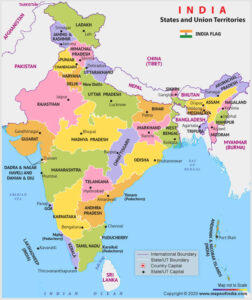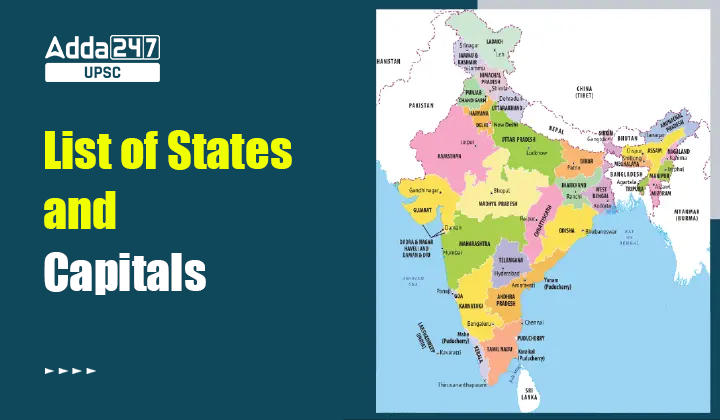Table of Contents
States and Capitals of India: India is a sovereign, secular, democratic, republic with a parliamentary form of government. It is a union of states. According to the constitution, the President leads the Union’s executive branch. As the President’s envoy in each state, the governor serves as the head of the executive branch. States have governmental structures that are very similar to the Union’s. The nation is made up of 28 states and 8 Union territories. The President appoints an Administrator to oversee Union Territories on their behalf. Every State/UT in India, ranging in size from largest to smallest, has its distinct history, culture, customs, festivals, and language.
Indian States and Capitals
India is the seventh-largest country in the world by area. This nation is made up of several states and union territories, each of which adds something special to the table and defines India as such. We’ll talk about the Indian states and capitals on this topic today. Alongside it, we have also talked about every State that was established following the country’s independence. When states were arranged based on language in 1956, there was a significant reorganization. Numerous new states and capitals were established in India by the State Reorganization Act of 1956. In addition, we talked about India’s capital cities and Union Territories. Let’s go through it together.
List of 28 States and Capitals of India
There weren’t many states when India gained its independence, but as we developed and expanded, we became a country with 28 states and 8 Union Territories. Every single one of them has its own identity and culture. The list of all Indian states, along with their capitals, is shown here.
| List of 28 States and Capitals of India | ||
| Sr N. | State Name | Capital |
| 1. | Andhra Pradesh | Amaravati |
| 2. | Arunachal Pradesh | Itanagar |
| 3. | Assam | Dispur |
| 4. | Bihar | Patna |
| 5. | Chhattisgarh | Raipur |
| 6. | Goa | Panaji |
| 7. | Gujarat | Gandhinagar |
| 8. | Haryana | Chandigarh |
| 9. | Himachal Pradesh | Shimla |
| 10. | Jharkhand | Ranchi |
| 11. | Karnataka | Bengaluru |
| 12. | Kerala | Thiruvananthapuram |
| 13. | Madhya Pradesh | Bhopal |
| 14. | Maharashtra | Mumbai |
| 15. | Manipur | Imphal |
| 16. | Meghalaya | Shillong |
| 17. | Mizoram | Aizawl |
| 18. | Nagaland | Kohima |
| 19. | Odisha | Bhubaneswar |
| 20.. | Punjab | Chandigarh |
| 21. | Rajasthan | Jaipur |
| 22. | Sikkim | Gangtok |
| 23. | Tamil Nadu | Chennai |
| 24. | Telangana | Hyderabad |
| 25. | Tripura | Agartala |
| 26. | Uttar Pradesh | Lucknow |
| 27. | Uttarakhand | Dehradun (Winter) Gairsain (Summer) |
| 28. | West Bengal | Kolkata |
Indian Union Territories and Capitals
In addition to its 28 states, India also has 8 union territories. Through the Lieutenant Governor, the Central government has direct jurisdiction over Union territories. Only two of the eight Union Territories-New Delhi and Puducherry-have legislative assemblies and chief ministers. The list of all eight Union Territories, along with the capital, is provided below.
| Union Territories and Capitals of India | ||
| S.No | Union Territory | Capital |
| 1. | Andaman and Nicobar Islands | Port Blair |
| 2. | Chandigarh | Chandigarh |
| 3. | Dadar and Nagar Haveli and Daman and Diu | Daman |
| 4. | Delhi | New Delhi |
| 5. | Jammu and Kashmir | Summer- Srinagar
Winter- Jammu |
| 6. | Lakshadweep | Kavaratti |
| 7. | Puducherry | Pondicherry |
| 8. | Ladakh | Leh |
States and Capitals of India Map
We also provide the Indian states and their capital map for your better understanding. candidates preparing for various exams can take the help of the Capitals of States map to remember their names from an exam perspective.

States formed after Independence
India was divided into 565 princely states before its independence. The main barrier to creating a powerful India was the independent government of these native princely republics. India was divided into three states at this time: the “Territories of British India,” the “Princely states,” and the French and Portuguese colonial territories. Except for Hyderabad, Junagadh, Bhopal, and Kashmir, 562 princely kingdoms had consented to become a part of the Indian Confederation upon the country’s independence.
Since India gained its independence, the state’s borders have continued to shift annually. Before the division, there were 565 princely states and 17 provinces; after the Reorganization of States in 1956, there were 14 states and 6 Union Territories. The list of states formed after Independence is provided below along with dates of formation:
- Jammu & Kashmir- Ladakh and Jammu & Kashmir signed the Instrument of Accession and were merged into the Indian Union; they became distinct union territories in 2019.
- Uttar Pradesh- In 1950, it underwent a reorganization and changed its name from United Province to Uttar Pradesh.
- Bihar- Created on January 26, 1950, as a complete state, Jharkhand was split off from Bihar in 2000.
- Assam- On January 26, 1950, it became a state after being restructured from a British province.
- Orissa (Odisha)- separated on April 1, 1936, and on January 26, 1950, it was granted statehood. In 2011, it was given the new name Odisha.
- Tamil Nadu- Originally the Madras Presidency, it was restructured as a state in 1950 and given the new name Tamil Nadu in 1969.
- Andhra Pradesh- formerly a part of Madras State; on November 1, 1956, it was split off to form the state of Telangana.
- Madhya Pradesh- Founded on November 1st, 1956, it was split off from Chhattisgarh in 2000.
- Kerala- On November 1, 1956, the former states of Travancore, Cochin, and Malabar united to form Kerala.
- Karnataka- founded on November 1, 1956, and renamed Karnataka in 1973 from its original name, Mysore State.
- Maharashtra- On May 1, 1960, the Bombay Province joined Gujarat to form Maharashtra.
- Gujarat- On May 1, 1960, Gujarat broke away from the Bombay Presidency to become its sovereign state.
- Nagaland- became a state after splitting off from Assam on December 1, 1963.
- Punjab- established with the union of Patiala and additional princely states; Haryana withdrew from it in 1966.
- The Himalayan State- Founded on January 25, 1971, it was first a union territory before becoming a state.
- Manipur- became a state on January 21, 1972, following its 1956 designation as a union territory.
- Meghalaya- On January 21, 1972, it separated from Assam, where it had previously existed as an autonomous state.
- Tripura- became a state on January 21, 1972, after leaving the union as a territory.
- Sikkim- On May 16, 1975, the state united with the Indian Union to become a complete unit.
- Goa- Freed from Portuguese domination in 1961, it was incorporated as a union territory and proclaimed a state on May 30, 1987.
- Arunachal Pradesh- became a state in 1987 after first existing as a union territory in 1972.
- Mizoram- proclaimed a complete state on February 20, 1987, following its time as an Assamese district and then a union territory.
- Chhattisgarh- split off from Madhya Pradesh on November 1, 2000.
- Jharkhand- formed on November 15, 2000, from Bihar.
- Uttarakhand- Originally composed of Uttar Pradesh districts and dubbed
- Uttaranchal- the region was renamed Uttarakhand in 2007.
- Telangana- formed on June 2nd, 2014, from the Andhra Pradesh region in the northwest.


 UPSC Prelims Exam Date 2024, Check New E...
UPSC Prelims Exam Date 2024, Check New E...
 UPSC Eligibility Criteria 2024- Age Limi...
UPSC Eligibility Criteria 2024- Age Limi...
 UKPSC RO ARO Result 2024 Out, Download M...
UKPSC RO ARO Result 2024 Out, Download M...







